Gelöste Aufgaben/Kw99: Unterschied zwischen den Versionen
Keine Bearbeitungszusammenfassung |
|||
| Zeile 35: | Zeile 35: | ||
{{MyCodeBlock|title=Header | {{MyCodeBlock|title=Header | ||
|text= | |text= | ||
Diese Aufgabe mit der [[Randwertprobleme/Methoden zur Lösung von Randwertproblemen/Finite Elemente Methode|Methode der Finiten Elemente]] in [[Gelöste Aufgaben/Kw96|KW96]] gelöst. | Diese Aufgabe mit der [[Randwertprobleme/Methoden zur Lösung von Randwertproblemen/Finite Elemente Methode|Methode der Finiten Elemente]] in [[Gelöste Aufgaben/Kw96|KW96]] gelöst. Und im Vergleich zu [[Gelöste Aufgaben/Kw98|KW98]] wird hier die analytische Lösung mit dimensionslosen Koordinaten angeschreiben. | ||
|code= | |code= | ||
<syntaxhighlight lang="lisp" line start=1> | <syntaxhighlight lang="lisp" line start=1> | ||
| Zeile 43: | Zeile 43: | ||
/* author: Andreas Baumgart */ | /* author: Andreas Baumgart */ | ||
/* last updated: 2017-09-06 */ | /* last updated: 2017-09-06 */ | ||
/* ref: TM-C, Labor 1 | /* ref: TM-C, Labor 1 - dimensionslos */ | ||
/* description | /* description: die Auslenkung w und die unabhängige */ | ||
/* | /* Ortskoordinate werden dim'los gemacht */ | ||
/*******************************************************/ | /*******************************************************/ | ||
</syntaxhighlight> | </syntaxhighlight> | ||
| Zeile 53: | Zeile 53: | ||
{{MyCodeBlock|title=Declarations | {{MyCodeBlock|title=Declarations | ||
|text= | |text= | ||
Wir definieren | Wir definieren die Formfunktionen für die Streckenlast | ||
::<math>\begin{array}{l}{{\phi}_{0}}\left( \xi\right) :=1-\xi\\{{\phi}_{1}}\left( \xi\right) :=\xi\end{array} \text{ mit } \xi = \displaystyle\frac{x_1}{\ell_1}</math>. | |||
::<math>\begin{array}{l}{{\phi}_{0}}\left( \xi\right) :=1-\xi\\{{\phi}_{1}}\left( \xi\right) :=\xi\end{array}</math>. | |||
|code= | |code= | ||
<syntaxhighlight lang="lisp" line start=1> | <syntaxhighlight lang="lisp" line start=1> | ||
/* system parameter */ | /* system parameter */ | ||
params: [EI[2]=EI[1]/2, | |||
params : [ | K[A]=EI[1]/l[1], | ||
k[B]=0, | |||
k[C] = EI[1]/l[1]^3, | |||
q[B]=4*q[A], | |||
l[2]=l[1]/2, | |||
M[B] = 5*q[A]*l[1]^2]; | |||
/* form - functions */ | /* form - functions */ | ||
| Zeile 78: | Zeile 72: | ||
}} | }} | ||
/* system parameter */ | |||
params: [EI[2]=EI[1]/2, | |||
K[A]=EI[1]/l[1], | |||
k[B]=0, | |||
k[C] = EI[1]/l[1]^3, | |||
q[B]=4*q[A], | |||
l[2]=l[1]/2, | |||
M[B] = 5*q[A]*l[1]^2]; | |||
/* form - functions */ | |||
phi[0](xi) := 1 - xi; | |||
phi[1](xi) := xi; | |||
<!--------------------------------------------------------------------------------> | |||
{{MyCodeBlock|title=Formfunctions | |||
|text= | |||
Y | |||
|code= | |code= | ||
<syntaxhighlight lang="lisp" line start=1> | <syntaxhighlight lang="lisp" line start=1> | ||
/ | Y</syntaxhighlight> | ||
}} | |||
<!--------------------------------------------------------------------------------> | <!--------------------------------------------------------------------------------> | ||
Für die 2*4 = 8 Integrationskonstanten | Für die 2*4 = 8 Integrationskonstanten | ||
| Zeile 178: | Zeile 151: | ||
für die Integrationskonstanten. | für die Integrationskonstanten. | ||
{{MyCodeBlock|title=Boundary Conditions | |||
|text= | |||
|code= | |code= | ||
<syntaxhighlight lang="lisp" line start=1> | <syntaxhighlight lang="lisp" line start=1> | ||
Version vom 31. März 2021, 12:28 Uhr
Aufgabenstellung
Ein Stab ABC ist durch eine lineare veränderliche Streckenlast q mit den Eckwerten qA in A und qB in B sowie dem Moment MB in B belastet. Der Stab (E-Modul: E) besteht aus zwei Sektionen mit den Längen l1 bzw. l2 sowie den Flächenmomenten I1 bzw. I2. Der Stab ist in A durch ein gelenkiges Festlager, in C durch eine Schiebehülse gelagert, in B sind die beiden Sektionen fest miteinander verbunden. Die Feder in A ist eine Drehfester mit Steifigkeit KA, die Federn in B und C sind Translationsfedern mit den Steifigkeiten kB, kC.
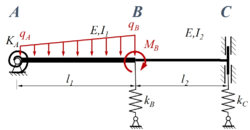
Gesucht ist die analytische Lösung für den Euler-Bernoulli-Balken. Im Vergleich zu Kw98 wird hier eine Lösung mit normierten Koordinaten versucht.
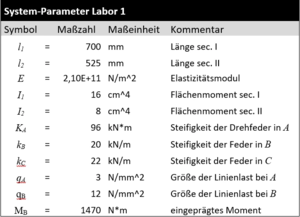
Ermitteln Sie für ein Euler-Bernoulli-Modell die analytischen Verläufe der Schnittgrößen und Verschiebungen im Balken für diese Parameter:
Lösung mit Maxima
Die Aufgabe ist ein klassisches Randwertproblem:
- zwei Gebiete, in denen ein Euler-Bernoulli-Balken in AB und BC durch eine Streckenlast q belastet ist (in Bereich II ist die Streckenlast allerdings Null) und somit durch die Differentialbeziehungberschrieben wird.
- Rand- und Übergangsbedingungen in den Punkten A, B, C
Wir verwenden xi und ξi als Koordinaten je Bereich, in der Übersicht sieht das Randwertproblem so aus:
| Rand A | Bereich I | Übergang B | Bereich II | Rand C |
|---|---|---|---|---|
 | 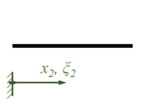 | |||
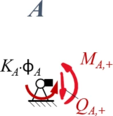 |  | 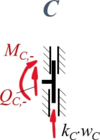
|
Header
Diese Aufgabe mit der Methode der Finiten Elemente in KW96 gelöst. Und im Vergleich zu KW98 wird hier die analytische Lösung mit dimensionslosen Koordinaten angeschreiben.
/*******************************************************/
/* MAXIMA script */
/* version: wxMaxima 15.08.2 */
/* author: Andreas Baumgart */
/* last updated: 2017-09-06 */
/* ref: TM-C, Labor 1 - dimensionslos */
/* description: die Auslenkung w und die unabhängige */
/* Ortskoordinate werden dim'los gemacht */
/*******************************************************/
Declarations
Wir definieren die Formfunktionen für die Streckenlast
- .
/* system parameter */
params: [EI[2]=EI[1]/2,
K[A]=EI[1]/l[1],
k[B]=0,
k[C] = EI[1]/l[1]^3,
q[B]=4*q[A],
l[2]=l[1]/2,
M[B] = 5*q[A]*l[1]^2];
/* form - functions */
phi[0](xi) := 1 - xi;
phi[1](xi) := xi;
/* system parameter */
params: [EI[2]=EI[1]/2,
K[A]=EI[1]/l[1],
k[B]=0,
k[C] = EI[1]/l[1]^3,
q[B]=4*q[A],
l[2]=l[1]/2,
M[B] = 5*q[A]*l[1]^2];
/* form - functions */ phi[0](xi) := 1 - xi; phi[1](xi) := xi;
Formfunctions
Y
Y
Für die 2*4 = 8 Integrationskonstanten
suchen wir jetzt die passenden Gleichungen aus Rand- und Übergangsbedingungen.
Zur besseren Übersicht nennen wir die Schnitt-Momente und -Kräfte nach den jeweiligen Knotenpunkten A, B, C und fügen als Index ein + / - hinzu, um die Seite (+: rechts vom Knoten, -: links vom Knoten) zu kennzeichnen.
Aus Rand "A"
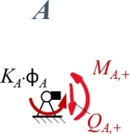
| Geometrische Randbedingungen
Kraft- und Momenten-Randbedingungen |
Aus Übergang "B"
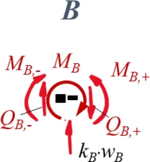
| Geometrische Randbedingungen
Kraft- und Momenten-Randbedingungen |
Aus Rand "C"
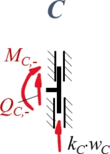
| Geometrische Randbedingungen
Kraft- und Momenten-Randbedingungen |
Und das liefert das Gleichungssystem aus 8 Gleichungen
für die Integrationskonstanten.
Boundary Conditions
1+1
Prepare for Solver
Das Gleichungssystem wollen wir als
schreiben, also
- Fehler beim Parsen (Unbekannte Funktion „\begin{pmatrix}“): {\displaystyle \begin{pmatrix}\frac{1}{{{\mathit{EI}}_{1}}} & 0 & 0 & 0 & 0 & 0 & 0 & 0\\ 0 & \frac{{{K}_{A}}}{{{\mathit{EI}}_{1}}} & -1 & 0 & 0 & 0 & 0 & 0\\ \frac{1}{{{\mathit{EI}}_{1}}} & \frac{{{\ell}_{{MyCodeBlock|title=Prepare for Solver |text= Das Gleichungssystem wollen wir als ::<math>\underline{\underline{A}}\cdot\underline{x}= \underline{b}}
schreiben, also
- Fehler beim Parsen (Unbekannte Funktion „\begin{pmatrix}“): {\displaystyle \begin{pmatrix}\frac{1}{{{\mathit{EI}}_{1}}} & 0 & 0 & 0 & 0 & 0 & 0 & 0\\ 0 & \frac{{{K}_{A}}}{{{\mathit{EI}}_{1}}} & -1 & 0 & 0 & 0 & 0 & 0\\ \frac{1}{{{\mathit{EI}}_{1}}} & \frac{{{\ell}_{{MyCodeBlock|title=Prepare for Solver |text= Das Gleichungssystem wollen wir als ::<math>\underline{\underline{A}}\cdot\underline{x}= \underline{b}}
schreiben, also
Die Matrix-Elemente sind für die Koeffizientenmatrix
und für die rechte Seite
- .
/* augmented coeff matrix */
ACM: augcoefmatrix(BCs,ICs);
AA : submatrix(ACM,9);
bb : - col(ACM,9);
for i: 1 thru 8 do
print(simplode(["b[",i,"] = ", string(bb[i][1])]))$
for i: 1 thru 8 do
for j: 1 thru 8 do
if not AA[i][j] = 0 then
print(simplode(["A[",i,",",j,"] = ", string(AA[i][j])]))$
Solving
Das Lösen des Gleichungssystems liefert
- .
1+1
Post-Processing
Und die Ergebnisse können wir uns anschauen ...
... für w(x):
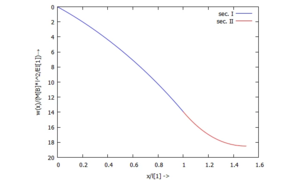
... für Φ(x):
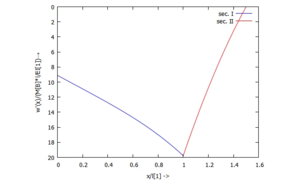
... für M(x):
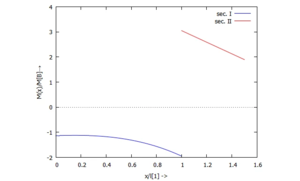
... für Q(x):
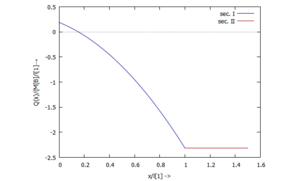
... für die Lager-Reaktionskräfte:
/* bearing forces and moments */
reactForces: [A[z] = Q[1](0),
M[A] = K[A]*Phi[1](0),
B[z] = k[B]*w[2](0),
C[z] = k[C]*w[2](1),
M[C] = M[2](1)];
expand(subst(dimless,subst(params,subst(sol, reactForces))));
/* plot displacements */
fcts: [[ w [1](xi), w [2](xi)],
[Phi[1](xi),Phi[2](xi)],
[ M [1](xi), M [2](xi)],
[ Q [1](xi), Q [2](xi)]];
facts: [1/l[Bez], l[1]/l[Bez], 1/(q[A]*l[1]^2), 1/(q[A]*l[1])];
textlabels : ["w(x)/(M[B]*l^2/EI[1])→", "w'(x)/(M[B]*l/EI[1])→", "M(x)/M[B]→", "Q(x)/(M[B]/l[1]→"];
for i: 1 thru 4 do(
f : expand(subst(dimless,subst(params,facts[i]*[subst(sol, fcts[i][1]),
subst(sol, fcts[i][2])]))),
r : subst(params,l[2]/l[1]),
preamble: if i<=2 then "set yrange [] reverse" else "set yrange []",
plot2d([[parametric, t, subst(t,xi,f[1]), [t,0,1]],
[parametric, 1+r*t, subst(t,xi,f[2]), [t,0,1]]],
[legend, "sec. I", "sec. II"],
[gnuplot_preamble, preamble],
[xlabel, "x/l[1] ->"],
[ylabel, textlabels[i]]))$
Links
- ...
Literature
- ...